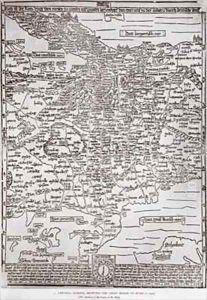Erhard Etzlaub Paintings
Erhard Etzlaub was a German cartographer, engraver, and mathematician who lived during the late 15th and early 16th centuries. Born around 1460, Etzlaub's contributions to cartography and navigation during the Renaissance were significant, albeit often overshadowed by his contemporaries. Operating from Nuremberg, a hub for scientists, artists, and thinkers of the time, Etzlaub was part of the vibrant intellectual and artistic culture that made the city a center for innovation in map-making and scientific instruments.
Etzlaub's work is notably characterized by his detailed and practical maps, which were designed not only for scholarly use but also for the burgeoning class of merchants and travelers. His maps often included roads and trade routes, making them some of the earliest forms of road maps in Europe, a precursor to the modern atlas. One of his most famous works is the 'Romweg Map', created in 1500, which depicted the routes to Rome for pilgrims traveling from different parts of Europe. This map was remarkable for its accuracy and detail, showcasing Etzlaub's skills in surveying and his understanding of geography.
Moreover, Etzlaub was known for his 'miniature sun dials', portable devices that incorporated his precise geographical knowledge to help determine time in different parts of Europe. These innovations underscored his mastery over the interplay between geography, time, and mathematics, reflecting the Renaissance's broader fascination with uncovering the workings of the natural world through science and exploration.
Despite his contributions, Erhard Etzlaub's name is not as widely recognized as some of his contemporaries. However, historians of cartography and Renaissance scholars have continued to study his works, recognizing their significance in the evolution of map-making and navigation. Etzlaub's maps and instruments not only aided travelers of his time but also contributed to the growing body of knowledge that would fuel European exploration and the eventual mapping of the globe. He is believed to have died around 1532, leaving behind a legacy that, though not widely celebrated, played a crucial role in the development of cartography and scientific instruments in early modern Europe.
